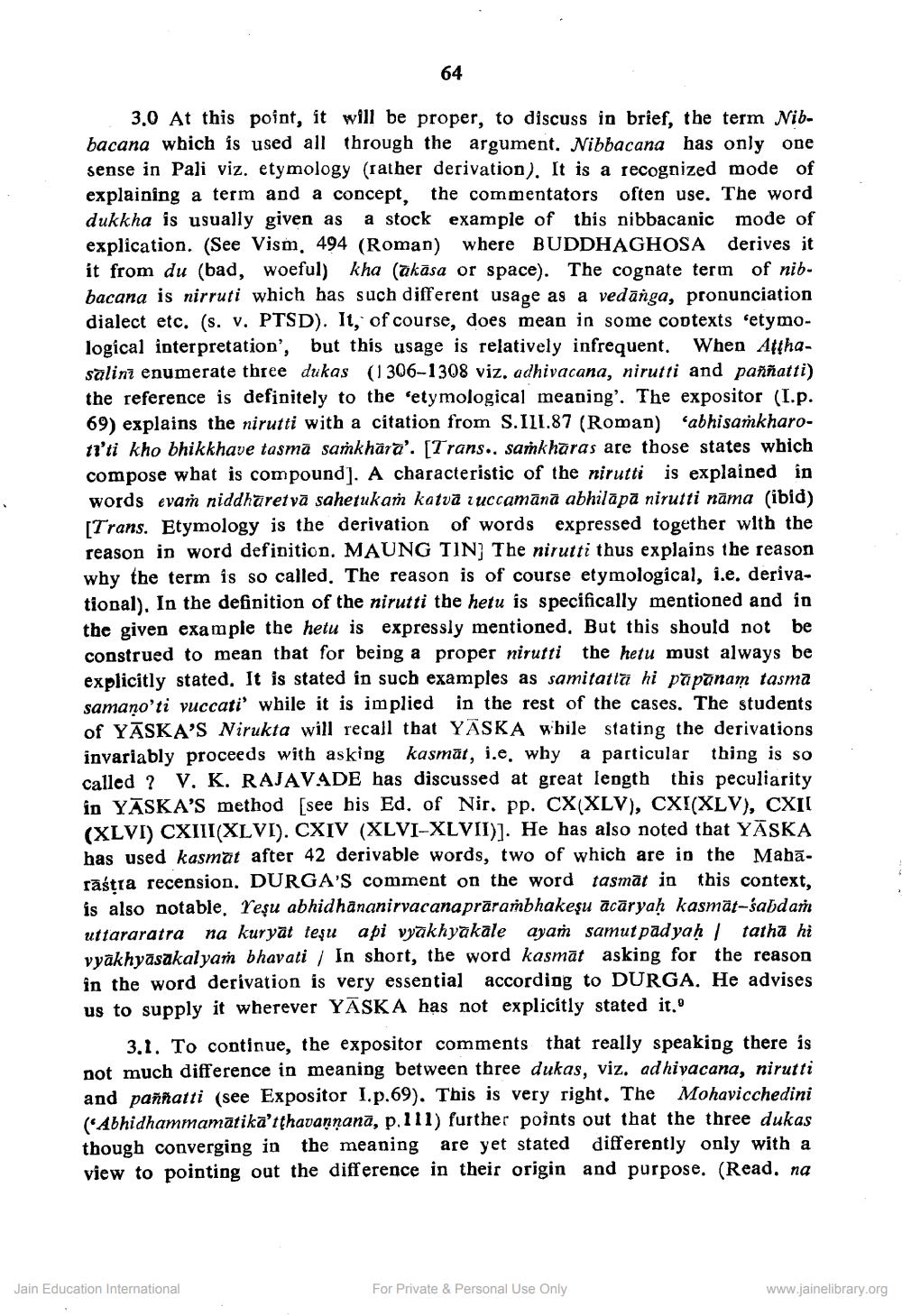________________
64
3.0 At this point, it will be proper, to discuss in brief, the term Nibbacana which is used all through the argument. Nibbacana has only one sense in Pali viz. etymology (rather derivation). It is a recognized mode of explaining a term and a concept, the commentators often use. The word dukkha is usually given as a stock example of this nibbacanic mode of explication. (See Vism, 494 (Roman) where BUDDHAGHOSA derives it it from du (bad, woeful) kha (ākāsa or space). The cognate term of nibbacana is nirruti which has such different usage as a vedanga, pronunciation dialect etc. (s. v. PTSD). It, of course, does mean in some contexts etymological interpretation', but this usage is relatively infrequent. When Atthasalini enumerate three dukas (1306-1308 viz. adhivacana, nirutti and paññatti) the reference is definitely to the etymological meaning'. The expositor (I.p. 69) explains the nirutti with a citation from S.III.87 (Roman) abhisamkharot'ti kho bhikkhave tasma samkhara'. [Trans.. samkhāras are those states which compose what is compound]. A characteristic of the nirutti is explained in words evam niddhāretvā sahetukaṁ katvā ruccamānā abhilāpā nirutti nāma (ibid) [Trans. Etymology is the derivation of words expressed together with the reason in word definition. MAUNG TIN] The nirutti thus explains the reason why the term is so called. The reason is of course etymological, i.e. derivational). In the definition of the nirutti the hetu is specifically mentioned and in the given example the hetu is expressly mentioned. But this should not be construed to mean that for being a proper nirutti the hetu must always be explicitly stated. It is stated in such examples as samitaṭṭā hi pāpānam tasmā samano'ti vuccati' while it is implied in the rest of the cases. The students of YASKA'S Nirukta will recall that YASKA while stating the derivations invariably proceeds with asking kasmat, i.e, why a particular thing is so called? V. K. RAJAVADE has discussed at great length this peculiarity in YASKA'S method [see his Ed. of Nir. pp. CX(XLV), CXI(XLV), CXII (XLVI) CXIII(XLVI). CXIV (XLVI-XLVII)]. He has also noted that YASKA has used kasmat after 42 derivable words, two of which are in the Maharaśṭra recension. DURGA'S comment on the word tasmat in this context, is also notable. Yeşu abhidhananirvacanaprarambhakeşu ācāryaḥ kasmät-sabdam uttararatra na kuryat teşu api vyakhyakale ayam samut padyaḥ | tatha hi vyakhyāsakalyam bhavati / In short, the word kasmat asking for the reason in the word derivation is very essential according to DURGA. He advises us to supply it wherever YASKA has not explicitly stated it."
3.1. To continue, the expositor comments that really speaking there is not much difference in meaning between three dukas, viz. adhivacana, nirutti and paññatti (see Expositor I.p.69). This is very right. The Mohavicchedini (Abhidhammamatika'tthavannana, p.111) further points out that the three dukas though converging in the meaning are yet stated differently only with a view to pointing out the difference in their origin and purpose. (Read. na
Jain Education International
For Private & Personal Use Only
www.jainelibrary.org




